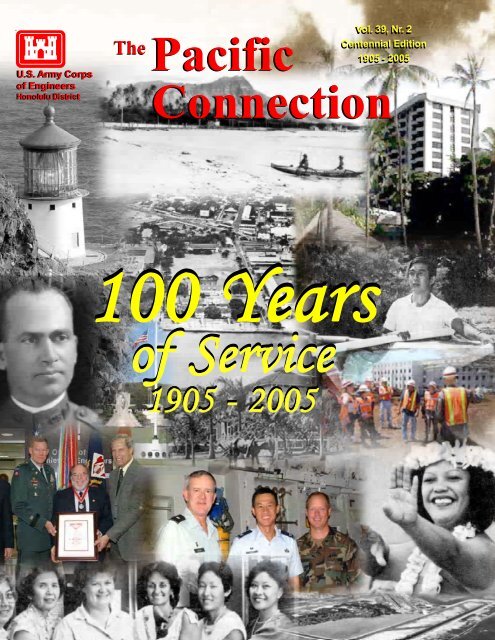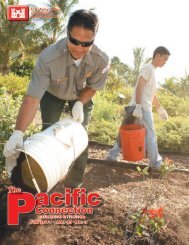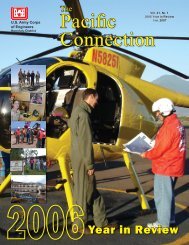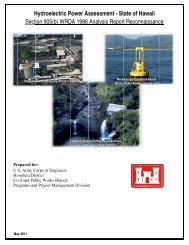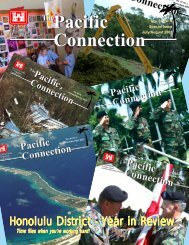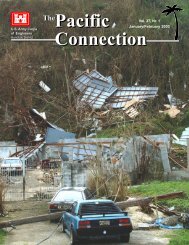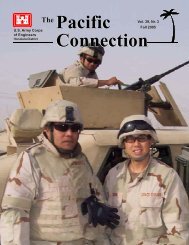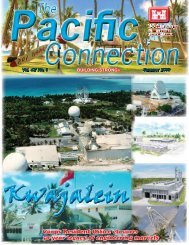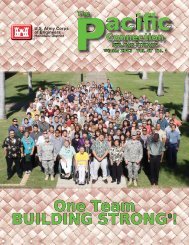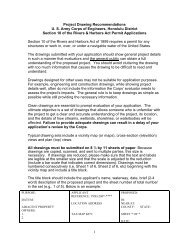The Pacific Connection - Honolulu District - U.S. Army
The Pacific Connection - Honolulu District - U.S. Army
The Pacific Connection - Honolulu District - U.S. Army
Create successful ePaper yourself
Turn your PDF publications into a flip-book with our unique Google optimized e-Paper software.
U.S. <strong>Army</strong> Corpsof Engineers<strong>Honolulu</strong> <strong>District</strong>Vol. 39, Nr. 2Centennial Edition1905 - 2005<strong>The</strong><strong>Pacific</strong><strong>Connection</strong>100 Yearsof Service1905 - 2005
2 <strong>The</strong> <strong>Pacific</strong> <strong>Connection</strong> Centennial Edition 1905-2005Commander’s CommentsLt. John Rudolph Slattery, HED’s first <strong>District</strong> EngineerLt. Col. David E. AndersonCommander and <strong>District</strong> Engineer“A Century of Service”I have been preceded by 63 other officers who had thehonor of commanding the <strong>Honolulu</strong> <strong>District</strong>.As a bit of a history buff, I found some interestinginformation on the first <strong>District</strong> Commander, Colonel John R.Slattery, which is included below.This issue celebrates the Centennial of the <strong>Honolulu</strong><strong>District</strong>, U. S. <strong>Army</strong> Corps of Engineers.It is dedicated to my predecessors and the thousands ofmen and women who have served under their command.Your projects, engineering feats and contributions havemade a lasting impact on the defense of our Nation and on thepeople of the <strong>Pacific</strong>.From Makapu’u Lighthouse, to Sand Island, SchofieldBarracks, Hickam Air Force Base, hundreds of runwaysthroughout the <strong>Pacific</strong> Ocean and the Palau Road – we are proudto be “America’s Engineers in the <strong>Pacific</strong>.”Enjoy this issue of the “<strong>Pacific</strong> <strong>Connection</strong>.” We lookforward to continuing to serve as we begin our second centuryof service.Cover design by RolandStine. <strong>The</strong> cover collagecelebrates the long, variedand distinguished historyof the <strong>Honolulu</strong> Engineer<strong>District</strong>, its projects andits people.John Rudolph Slattery graduated 5th in the WestPoint Class of 1900. Born in Athens, Ohio, on Jan. 31, 1877,he was appointed to the Academy by Charles P. Taft, brotherof President William Howard Taft.After graduation, Slattery was assigned to thePhilippines to work on bridges and roads—a typicalbeginning for an engineer officer.<strong>The</strong> next few years found him living in <strong>Honolulu</strong>,Hawaii, where he founded the Corps of Engineers <strong>District</strong>;Jacksonville, Florida and Vicksburg, Mississippi, where heremained for several years and worked on the Flood of 1916.He then served in France during World War I as the ChiefEngineer of the Seventh <strong>Army</strong> Corps until 1919.One of his contributions was the development of aproject on the upper Hudson River known as the Port ofAlbany. After it was completed, oceangoing vessels couldtravel 150 miles inland from New York City.While working on the project, Slattery was noticedby John Delaney, Dock Commissioner of New York City, whowas impressed with Slattery’s work and wanted him to serveas one of Delaney’s chief aids on the new system oftransportation in New York- the subway.In an unusual move, the <strong>Army</strong> granted Slattery ayear’s leave of absence so he could work on the subwaysystem. At the end of that year, Slattery had served 25 yearsand wanted to retire, but the Secretary of War would notallow it.Slattery eventually retired as a Colonel in 1925 andbecame the Deputy Chief Engineer of the Board ofTransportation, in charge of such projects as the tunnels toQueens and Staten Island and the New York Central Railroad.Slattery earned a master of arts from Ohio University.He was a member of the American Society of Civil Engineersand past president of the Society’s New York section,American Military Engineers and the Municipal Engineers.He also received accolades from the mayor of NewYork for his work. <strong>The</strong> intersection of Queens andWoodhaven Boulevards in Queens, NY, is named SlatteryPlaza in his honor.He suffered a heart attack while working in 1932and died several days later in Jackson Heights, NY, at theage of 55.Editor’s note:Over our first100 years, the <strong>Honolulu</strong> <strong>District</strong> has undergone a numberof reorganizations and subsequent name changes. <strong>The</strong> <strong>District</strong> andits essence has endured. For the sake of simplicity in this publication,we will refer to <strong>Honolulu</strong> Engineer <strong>District</strong> as HED.This newspaper is printedon recycled paper.<strong>The</strong> <strong>Pacific</strong> <strong>Connection</strong>, an unofficial publication authorized by AR360-1, is a periodical produced by thePublic Affairs Office, <strong>Honolulu</strong> <strong>District</strong>, U.S. <strong>Army</strong> Corps of Engineers, Fort Shafter, HI 96858-5440.Telephone (808) 438-9862. This command information publication is for employees and others who requestit in writing and is also available on line: http://www.poh.usace.army.mil/. Contents are not necessarilythe official views of, or endorsed by, the U.S. Government, the Department of Defense or theDepartment of the <strong>Army</strong>. Circulation: approximately 1,100.<strong>Honolulu</strong> <strong>District</strong> Commander.......... Lt. Col. David E. AndersonChief, Public Affairs .......................................... Joseph BonfiglioMedia Relations Specialist ........................... Dino W. BuchananEditor .......................................................................... Sarah H. Cox
Centennial Edition 1905-2005 <strong>The</strong> <strong>Pacific</strong> <strong>Connection</strong> 3<strong>Honolulu</strong> Engineer <strong>District</strong> Celebrates“100 Years of Exemplary Service”Excerpt from Congressional Record, April 15, 2005Mr. INOUYE: Mr. President, on April 15, the U.S. <strong>Army</strong> Corps of Engineers,<strong>Honolulu</strong> Engineer <strong>District</strong> (HED) will celebrate 100 years of exemplary service toHawaii, the <strong>Pacific</strong> region, the U.S. military and the Nation.For an entire century, the <strong>District</strong> has served with pride and distinction.I have personally witnessed their hard work and dedication to improve the lives ofour fellow citizens in many ways. <strong>The</strong>y have never failed to answer the call.<strong>The</strong> <strong>District</strong> has had a significant impact on the ability of ourservicemen and women to fight the global war on terror, it has bolstered the region’seconomy and worked to enhance the safety of communities in and about waterwaysand the functionability of the many major harbors in my home State of Hawaii. Ineverything they do they safeguard the environment.From civil works projects navigation, flood control and shore protectionto building and maintaining the infrastructure for our military personnel, the <strong>Honolulu</strong><strong>District</strong> is proud of its service.<strong>The</strong> U.S. <strong>Army</strong> Corps of Engineers’ missions in the <strong>Pacific</strong> regionhave expanded exponentially since the unit’s conception in 1905 when Lt. John R.Slattery was designated as <strong>Honolulu</strong> <strong>District</strong> Engineer on the Island of Oahu.<strong>The</strong> mission of the Twelfth Lighthouse <strong>District</strong> was to design andconstruct lighthouses for navigation, acquire land for military fortifications, improvethe harbors and expand the Corps’ services to other <strong>Pacific</strong> islands.In its first 100 years, the <strong>Honolulu</strong> <strong>District</strong> has supported the militaryin peace and in war, helped protect the island from enemies and forces of nature,protected the environment and wetlands, and added to Hawaii’s economic growth.HED’s legacy includes: the creation of Sand Island; the acquisition ofthe Fort DeRussy area in Waikiki; the expansion of <strong>Honolulu</strong> Harbor; therepair of Hickam, Wheeler and Pearl Harbor airfields after the December 1941attack; the construction of the National Memorial Cemetery of the <strong>Pacific</strong> atPunchbowl, the Tripler <strong>Army</strong> Medical Center, the Hale Koa Hotel andnumerous military and federal construction projects; and the creation of theKaneohe-Kailua Dam, as well as a host of disaster mitigation and assistancemeasures.At the beginning of the 20th Century, HED constructed six deep-draftharbors on the five major Hawaiian Islands and three crucial lighthouses fornavigation.Under Slattery’s command, the <strong>District</strong> began transforming theswampy coral reef used as a quarantine station in <strong>Honolulu</strong> Harbor into what isnow known as Sand Island. Lt. Slattery’s contributions are honored today with theLt. John R. Slattery Bridge which connects Sand Island with the city of <strong>Honolulu</strong>.He later purchased the 74-acre Fort DeRussy area in Waikiki for just$2,700 an acre for use as a military fortification. At the time, the land was littlemore than a swampy parcel. Today the area provides a valuable green oasis in theheart of Waikiki....Changes in technology and the approach of World War I changedHED’s missions. Batteries and forts were supplemented with artillery firecontrol and submarine mine defense systems....<strong>The</strong> <strong>District</strong>’s role in the <strong>Pacific</strong> increased dramatically duringWorld War II. At the height of the war, HED employed more than 26,000people. Not only was the <strong>District</strong> creating the new airfield ferry routes andrepairing the damaged air fields at Hickam, Wheeler and Pearl Harbor, but the<strong>District</strong> was also tasked with additional responsibilities outside its normalrealm.<strong>The</strong> <strong>District</strong> was suddenly responsible for determining shippingpriorities in the harbor; converting sugarcane and pineapple plantations to vegetablefarms; organizing the rationing program for oil and other consumer goods;camouflaging equipment and landmarks; building trenches and air raid shelters;erecting radar stations and excavating extensive underground rooms and tunnelsfor ammunition storage.Before war was declared, the <strong>District</strong> had been creating a new AirfieldFerry Route System. <strong>The</strong> original route from the Philippines, Marianas, WakeIsland, Midway, Hawaii to California was considered vulnerable to Japanese attack.New air ferry routes to the east and south were necessary to the war effort and themilitary buildup in Australia.Building seven runways and support facilities on small, remote islandspresented a number of challenges involving materials, manpower and water shortages,communication, transportation and geographical topography. <strong>The</strong> southern route,from California, Hawaii, Christmas, Canton, Fiji, New Caledonia to Australia andthe eastern route, from Christmas, Penrhyn, Aitutaki, Tongatabu, Norfolk to Sydney,were finished by the 1-year anniversary of the attack on Pearl Harbor—an impressiveaccomplishment by any standard.When the war ended, HED had constructed 69 miles of runways andtaxiways and 2,700,000 square yards of aircraft parking area....<strong>The</strong> Corps was also busy with major endeavors including constructionof Tripler <strong>Army</strong> Medical Center, the National Memorial Cemetery of the <strong>Pacific</strong> atPunchbowl, and flood control and shore protection projects critical to the safetyand future enjoyment of many communities.Tripler <strong>Army</strong> Medical Center, commonly known as the “Pink Lady,”was completed in 1948 at a cost of $40 million. <strong>The</strong> 14-story, 1,500-bed hospitalwas an extensive project featuring 12 separate buildings – each constructed separatelyto make the Medical Center earthquake resistant. Today, Tripler continues servingmilitary members and their families from around the <strong>Pacific</strong> as well as Hawaii’sveterans and military retirees.During the 1960’s and 1970’s, new federal policies further expandedHED’s duties. <strong>The</strong> National Environmental Policy Act of 1969 required the Corpsto prepare environmental impact statements, EIS, on all proposed federal actionsaffecting the environment. <strong>The</strong> Clean Water Act of 1977 brought changes to theCorps’ regulatory mission and required the Corps to issue permits for all dredgedor fill material. <strong>The</strong> Corps was now responsible for all the nation’s water andwetlands—a scope that now stretches far beyond navigable waters. This began theCorps’ mission as “Stewards of the Environment”....Civil works and capital improvement programs expanded to Guam,American Samoa, Kwajalein and the Commonwealth of the Northern MarianaIslands. Main projects on Oahu included building military housing and improvingfacilities at Hickam AFB, Wheeler, Schofield, Aliamanu and Fort Shafter.In 1973 HED began construction of the Hale Koa Military Rest andRecreational Hotel at Fort DeRussy in Waikiki. <strong>The</strong> original highrise hotel towerhas 416 rooms, 15 floors and was built for $15.7 million.Nearby Battery Randolph was transformed into the U.S. <strong>Army</strong>Museum. <strong>The</strong> second floor of the museum today houses the U.S. <strong>Army</strong>Corps of Engineers <strong>Pacific</strong> Regional Visitors Center.<strong>The</strong> Corps’ responsibilities were further defined in 1980 with theaddition of an Emergency Management Division....HED today continues to serve a variety of missions in a region of12 million square miles from Hawaii to Micronesia an area of operationsspanning five time zones, the equator and the international dateline. This theyhave done with the utmost of professionalism, integrity and an unwaveringcommitment to service.I am truly honored to have the <strong>Honolulu</strong> Engineer <strong>District</strong> in myhome State. <strong>The</strong>y serve as “America’s Engineers in the <strong>Pacific</strong>,” I have nodoubt that they will continue their service and legacy with pride and aloha forthe next hundred years and beyond. Happy Birthday. Congratulations on ajob well done. On behalf of a grateful Nation, thank you for your service.Mahalo and Aloha,Daniel K. Inouye, USS
4 <strong>The</strong> <strong>Pacific</strong> <strong>Connection</strong> Centennial Edition 1905-20051905-1910<strong>The</strong> Beginning<strong>The</strong> “Lighthouse on the Reef”, <strong>Honolulu</strong> Harbor, circa 1900, was removed whenHED widened the harbor.HED’s first <strong>District</strong> Engineer, Lt. John R. Slattery, arrives in<strong>Honolulu</strong> in November 1904. On April 15, 1905, Slattery opensthe first HED office on Bishop Street. His duties grew to includeacquiring land for military fortifications, improving Hawaii’sharbors and expanding the Corps’ service to other <strong>Pacific</strong>islands. He bought the land at Ft. DeRussy for just $2,700 anacre to use as a military fortification. At the time the land waslittle more than a swampy parcel. Now the land provides avaluable green oasis in the heart of Waikiki.<strong>Honolulu</strong> Harbor, circa 1900: HED begins dredging the harbor in November 1905.<strong>The</strong> material obtained from the dredging was used to reclaim Sand and QuarantineIslands. <strong>The</strong> islands calm the harbor eliminating any need for a breakwater.In May 1906, the sailing ship Martha Davis burned and sank inHilo’s harbor. After bids to remove the wreckage were too costly, Lt. Slatteryhired contractors to dig underneath the wreckage allowing the Davis tobecome buried in the harbor. This begins HED’s reputation for ingeniousideas and innovative problem solving.<strong>The</strong> <strong>District</strong> also began improvements to Hilo Harbor with constructionof the rubbermound breakwater in Sept. 1908. In 1910, HED extendedthe breakwater at Kahului Harbor.Lt. Slattery prepared the design for Makapu’u Lighthouse. HEDbuilt the “wonder of Oahu” in 1909. Its construction exemplifiesthe variety of HED’s endeavors and is one of several lighthousesbuilt during HED’s reign as administrator of the Lighthouse<strong>District</strong>. On June 17, 1910, Congress establishes the Bureau ofLighthouses under a civilian staff, designating the Corps asconsultants instead of administrators.Ft. Shafter’s Officers’ quarters, circa 1910: the <strong>District</strong> played a crucial role inhelping Ft. Shafter become a major anti-aircraft installation. <strong>The</strong> <strong>District</strong> built anumber of military fortifications for Oahu’s defense including Pearl Harbor, FortsRuger, Armstrong, Weaver, Barrette and Kamehameha as well as Batteries Randolph,Williston, Hatch, Dudley and Harlow.
Centennial Edition 1905-2005 <strong>The</strong> <strong>Pacific</strong> <strong>Connection</strong> 51911 - 1920Mapping Oahu’s DefenseIn the early 20th century, HED’s civil works, supply and military construction missions expanded. <strong>The</strong> newly opened PanamaCanal made Hawaii a <strong>Pacific</strong> hub and increased the need for deeper and larger harbors and better lighting. HED expanded <strong>Honolulu</strong>, Hilo,Kahului and Nawiliwili Harbors. With the approach of WW I and the advent of airpower, HED fulfilled Oahu’s need for defense. By 1911HED had built Batteries Dudley and Randolph at Ft. DeRussy as well as Ft. Armstrong and Ft. Harlow. <strong>The</strong> Corps was also tasked withcreating a detailed map of Oahu. In 1912, Major Winslow, <strong>Honolulu</strong> <strong>District</strong> Engineer and Commander of the 1st Battalion of Engineers,and his company finished the map which allowed the Coast Authority to prepare a comprehensive land defense scheme for Oahu. In additionto the batteries, maps and portable lighthouses, HED also developed an artillery fire control system and an electronic submarine mine defensesystem. In 1913, the DE assumed the additional role of the Hawaiian Department Engineer. <strong>The</strong> Hawaiian Department was responsiblefor overseeing the various elements of Oahu’s defenses.Fort Shafter officer quarters in cantonment, circa 1916. In 1917, HED built the EngineerDepot at Fort Shafter. <strong>The</strong> advent of military aircraft changed HED’s missions. Airstripshad to be built and guns that originally guarded against enemy ships had to be replacedwith guns that could intercept aircraft. HED was instrumental in transforming many ofOahu’s batteries and for turning Ft. Shafter into a major anti-aircraft installation.HED played a crucial role in Oahu’s early defense by buildinga number of military fortifications such as this one onDiamond Head Lookout.By 1913, Oahu had eight coastal batteries guardingthe naval base at Pearl Harbor and the port of<strong>Honolulu</strong>, including four at Ft. Kamehameha; one at Ft.Armstrong; two at Ft. DeRussy and one at Ft. Ruger.<strong>The</strong> Navy had dredged the harbor and placed thedredge material at Ft. Kamehameha to build up thesubmerged land.<strong>The</strong> original Tripler Hospital, Fort Shafter, Palm Circle, circa 1920. <strong>The</strong> hospital, built in 1907 was redesignated as Tripler General Hospitalin 1920, honoring Brig. Gen. Charles Tripler, author of “Manual of the Medical Officer of the United States <strong>Army</strong>.”
6 <strong>The</strong> <strong>Pacific</strong> <strong>Connection</strong> Centennial Edition 1905-20051921 - 1929Calm Before <strong>The</strong> Storm<strong>The</strong> 1920s were not exactly roaring for the <strong>Honolulu</strong> Engineer <strong>District</strong>. As WW I military projects and civil works surveys werebeing wrapped up, HED built roads and laid an underground cable almost all around the island for fire control.HED’s work load did increase after the Naval Conference of 1921-1922 called for a moratorium on capital ship building. Thismoratorium allowed the Navy to transfer four of its surplus 16-inch guns to the <strong>Army</strong> in Hawaii. HED constructed batteries for the newguns at Ewa and the North Shore along with the necessary support facilities and machinery such as railroads, locomotives, power plants,magazines plotting and switchboard rooms.HED saw an increase in civil work projects in 1925 after the Treaty of 1922 prevented the U.S. from fortifying the Philippines, Guamor Wake. Hawaii could now receive the funds and the <strong>Army</strong>’s undivided attention necessary to improve its harbors and defenses. Hawaiialso had the advantage of local business support for many of the harbor improvement projects-including three pineapple companies whoagreed to pay for the initial dredging of Reserved Channel.In 1926, HED’s missions once again changed when HED’s <strong>District</strong> Engineer no longer had to wear two hats - jettisoning the titleof Hawaiian Department Engineer.1920s Milestones1921: HED built the Nawiliwili Harborbreakwater in Kauai and beganenlarging its entrance channel andharbor basin.1922: HED moves to the new <strong>Honolulu</strong>Federal Building at Richards andMerchant Streets.1922: Completed the concrete EngineerWharf at <strong>Honolulu</strong> Harbor.Sept. 1924: Williston Battery atIroquois Point in Ft. Weaver is completed.1927: Reserved Channel createdwhich divides Sand Island from the<strong>Honolulu</strong> waterfront.Ft. Shafter’s Palm Circle, circa 1920: Today,the area is designated as a historical landmark.Military families enjoy the swimming tank at Fort DeRussy in 1924. In 1911, a deep channel was dredged throughthe reef in front of Ft. DeRussy to facilitate the installation of the 69-ton guns at Battery Randolph. This dredgedchannel served as a swimming tank for Soldiers and their families. Lt. John Slattery, HED’s first DE, purchasedthe 74-acre Ft. DeRussy for just $2,700 an acre as a military fortification. Today the area is a major recreationarea for the community with a park, jogging trail, the U.S. <strong>Army</strong> Museum, the USACE <strong>Pacific</strong> Regional VisitorCenter and the Hale Koa Hotel.(L & R) Oahu’s firstcoastal fortification,Battery Harlow at Ft.Ruger, circa 1924: HEDbuilt Battery Harlow in1910 at Diamond Head.Its eight 12-inch gunswere contained in twoconcrete pits which werepraised for their strength.When the guns were testfired,only one smallcrack appeared in theconcrete.
Centennial Edition 1905-2005 <strong>The</strong> <strong>Pacific</strong> <strong>Connection</strong> 71930 - 1939Economic Recovery<strong>Honolulu</strong> Engineer <strong>District</strong> (HED) played a big part in helping Hawaii recover from the Great Depression. In 1931 HED builtroads, underground storage magazines and various structures at Aliamanu. <strong>The</strong> budget was supplemented with National IndustrialRecovery Act (NIRA) projects.Military projects were augmented by civil works projects. <strong>The</strong> Public Works Administration (PWA) called for billions of dollarsto be spent on large projects to help provide employment, stabilize purchasing power and improve America’s economy. In Aug. 1933,HED’s <strong>District</strong> Engineer was appointed to be a representative of the PWA for the Territory, thus beginning the “Partnership” of HED andHawaii. <strong>The</strong> partnership grew as the Corps was designated as the federal construction agency for flood control in 1936.HED administered many PWA projects such as additions to Roosevelt and Thomas Jefferson schools, Roosevelt Auditoriumand community civil works projects such as the Kuakini St. Bridge and expanding the water supply systems on Oahu, Molokai, Kauai andHawaii.Although these projects were not that large, they helped improve Hawaii’s economy and signaled the start of a new beginning for HED.In 1938, HED DE Maj. Peter E. Bermel assumed the responsibility for the Public Works and the Works Progress (WPA)Administrations in the Territory. Although Washington had the final say concerning WPA projects, the DE’s new responsibilities yielded alot of power and sparked local criticism when he recommended or vetoed WPA projects. With the additional workload, HED outgrew itsoffices and moved to Pier 2-A near the Engineer Storehouse.In the latter part of the decade with the threat of warapproaching, WPA projects began to take a back seat to militaryconstruction projects further fueling the local criticism. In 1937HED constructed chemical storage facilities at Schofield Barracks.As tensions with Japan increased, HED’s mission expanded intothe <strong>Pacific</strong> with the beginning of the Welles Harbor project onMidway in 1938.<strong>The</strong> 12-inch guns of Battery Clossen, Ft. Kamehameha were originallydesigned for war in France. Oahu was often called the “<strong>Pacific</strong> Gibraltar”due to its many coastal batteries.<strong>The</strong> 16-inch guns of Battery Hatch at Ft. Barrette were mounted in 1934 to allowfor a 360-degree field of fire.HED widened <strong>Honolulu</strong> Harbor to 500 feet in 1934 with money receivedfrom the NIRA. A lighthouse commissioned by the Corps in 1910 wasremoved to accommodate the enlargement. Other NIRA/WPA projectsincluded Kaunakakai Harbor and Port Allen navigational improvements,removing a portion of Sand Island and revetting the cut shoreline. Projectslike these signaled a new beginning for HED and helped Hawaii recover fromthe Great Depression.
8 <strong>The</strong> <strong>Pacific</strong> <strong>Connection</strong> Centennial Edition 1905-2005Pre-WW II: 1940- 1941War Preparations“ If we had had theEngineers on the entireconstruction program lastyear they would havemoved in with an experiencedorganization andmuch waste would havebeen avoided”-Robert P. Patterson, Under Secretary ofWar, in an Aug. 28, 1941 memo to the PresidentRoosevelt calling for all <strong>Army</strong> construction workto be transferred from the Quartermasters to theCorps of Engineers. F.D.R. approved the changeand it was signed into law Dec. 1, 1941.After the Dec. 7, 1941 attack on Pearl Harbor, <strong>Honolulu</strong>Engineers repaired the airstrips on Hickam and Wheeler andcreated new airfield ferry routes across the <strong>Pacific</strong> with recordbreakingspeed--prompting this editorial by Lorrin P. Thurstonthen President of the <strong>Honolulu</strong> Advertiser. Below is an excerptfrom the Feb. 26, 1942 column.A Tribute to a Driving WorkProducing GeniusLast week I stood on a finished airport, oneof many. On December 7, there was nothing therebut sand and swamp. <strong>The</strong> magnitude of the jobwhich was accomplished is breathtaking—that is theonly word that can be fairly used to describe whathas been done.This was only one of the countless dozenof completed projects on many of which work is stillgoing on full blast. Each needed tons of material,thousands of men, equipment mounting intothousands of individual items. <strong>The</strong>y had to begotten from some place. Millions of dollars of costswere involved….However, out of the whole chaotic mess,one thing stands out and that is, that this one man{HED <strong>District</strong> Engineer Col. <strong>The</strong>odore Wyman, Jr.}is the spark plug, the executive head and the drivingforce which got ready and turned over to the <strong>Army</strong>,an incredible number of “must” installations in afraction of the time normally required.As WW II approached, portable storage units such as this one at Wheeler <strong>Army</strong> Air Field,circa 1930. were replaced with extensive underground rooms and tunnels for ammunitionstorage at many locations on Oahu. One worker commented that the Engineers had built somany tunnels, if placed end to end-- the entrance would be at Koko Head, the exit atMoanalua.Prior to the attack on Pearl Harbor, HED was enlarging and modernizingfacilities at Ft. Shafter and Schofield Barracks, building anti-aircraft gun sites,bomb-proofing coastal fortifications and building bunkers at Wheeler <strong>Army</strong> AirField. HED was also finishing extensive work on Hickam Field including a hospital,dental clinic, an engineering shop, barracks, an NCO club, pool and perimeterfencing.After France fell in 1940, America urgently prepared for war and HEDplayed a crucial role in those preparations. In June 1940 the War Departmentauthorized HED to construct three aircraft warning fixed stations: Kaala on Oahu,Haleakala on Maui, Kokee on Kauai and six mobile stations. <strong>The</strong>y were notoperational the day Japan attacked Oahu.Before war was declared, the <strong>District</strong> had been creating a new Airfield FerryRoute System. <strong>The</strong> original route from the Philippines, Marianas, Wake Island, Midway,Hawaii to California was considered vulnerable to Japanese attack. New air ferry routesto the east and south were necessary to the war effort and the military build-up inAustralia.On Oct. 4, 1941, the War Dept. orders HED to begin construction on the newroutes. Building numerous runways and support facilities on small, remote islandspresented a number of challenges including material, manpower and water shortages,communication, transportation and geographical topography problems.Both routes were finished by the one-year anniversary of the attack on PearlHarbor in spite of the fact that airfield pavement was a new and unfamiliar area--animpressive accomplishment even in war time.
Centennial Edition 1905-2005 <strong>The</strong> <strong>Pacific</strong> <strong>Connection</strong> 9WW II: 1941-1943<strong>Pacific</strong> DefensesU.S. Engineers Busy Plugging AllPossible Leaks in Isle DefensesTeamwork Is Keynoteof Builders’ ProgramEver since war burst in Hawaii’sface the hunt for heroes has gone ata good clip. One hunting groundoverlooked so far is the Corps ofEngineers, as the ContinentalCongress of 1775 first named them.While the spotlight of Hawaiiwas fixed on the new stars in themilitary galaxy, these builders of thearmy, with no chance to sparkle, werebusy plugging all possible leaks in theIsland fortifications.<strong>The</strong> men whose technicalengineering skills puts might into thepunch of other combat units werehanded the most burdensome and leastspectacular job at the mobilizationfor total war. Though the casual eyemay fail to see much proof, it is therejust the same.Helping ‘Hold That Line”Unlike star players in a footballgame, none of the engineers couldrace down the battlefield while thecrowd shrieked ‘Hold that line,’ andscore a triumphant touchdown. ButEarly World War-II Milestonesthey could—and did —showteamwork that was a credit toAmerican ingenuity. <strong>The</strong>y not only‘held the line,’ they built some of itunder enemy fire and the rest inpractically nothing flat.<strong>The</strong> U.S. engineers know betterthan any other arm of the servicethat there is no royal road to victory.<strong>The</strong>y build that road, literally as wellas figuratively. In peace, they aretrained and disciplined to roadbuildingon a grand scale, to surveyingboundaries and mapping new landsto building lighthouses, dockyards,dams for flood control, to improvingwaterways in harbors and rivers sothat the life force of an industrialnation—its commerce — might flowfreely as the tide.In war their tasks becomeHerculean. With little opportunitiesto shine as individual Hercules, thesetechnical experts as a close-knit teamshared the service family’sresponsibility and integrity withAmerica in her supreme test and carrya heavy load withal.- excerpt, <strong>Honolulu</strong> Advertiser,Feb. 26, 1942March 1941 to Sept. 1943: Barracks, utilities, runways and taxiwaysconstructed on Bellows <strong>Army</strong> Air Field. Runways started before the attackwere expanded from 2,220 ft. to 4,900 ft. to accommodate B-17s. Area wascompleted in blackout conditions and rain one hour before the first four U.S.planes landed.Dec. 23, 1941: Japanese capture Wake Island. Prior to this, HED had plansto create a harbor on Wake similar to the Welles Harbor project.Dec. 27, 1941: 5,000 ft. runway at Tontouta, New Caledonia completed.1942: Underground gasoline ammunition storage facilities constructed atvarious locations.Jan. 20, 1942: Christmas Island runway completed.March 1942: Start of an extensive cold storage building program on the islands.Design Division developed a self-contained, 200-300 cu. ft. capacitywalk-in portable reefer box for use in isolated areas.1943: Tunnel near Kipapa Gulch, believed to be the first steel-lined gasolinestorage tunnel ever constructed. HED constructed so many tunnels, it wasestimated that if all the tunnels blasted on Oahu during the war were place endto end, the entrance would be at Koko Head and the exit at Moanalua.1943-1944: HED built six Prisoner-of-War camps on Oahu: Honouliuli Gulch,Wahiawa, Sand Island, Schofield Barracks, Fort Hase and Kalihi Valley.Jan. 1, 1943: Brig. Gen. Kramer established the “Bottleneck Buster Division”to simplify procedures in managing the many different new units. Bymid February, Kramer’s executive officer had broken some 400 bottlenecksand dramatically improved the <strong>District</strong>’s efficiency.Feb. 1943: HED begins creating a rear entrance to <strong>Honolulu</strong> Harbor at theurging of Brig. Gen. Kramer to Lt. Gen. Emmons. Considered a militaryemergency, the channel was to be 10,000 ft. long with a pontoon bridge. <strong>The</strong>project was abandoned after the war and not resumed again until 1960.After the Dec. 7th attack, the <strong>District</strong> was suddenly tasked with additionalresponsibilities outside its normal realm and needed additional space to carry onits many new missions. HED moved into Punahou School on Dec. 8, 1941, leasingthe compound for $20,000 a month until Sept. 8, 1945.Six days before Pearl Harbor was attacked, all <strong>Army</strong> constructionprojects were transferred to HED from the Quartermaster Department.Simultaneously, HED acquired responsibility for <strong>Army</strong> and Air Forcereal estate in Hawaii. An explosion of work soon followed.This brought HED into new fields of work with more than 26,000employees. HED repaired the damaged airfields on Hickam andWheeler in record time while completing the new air ferry routes.Practically overnight, the <strong>District</strong> Engineer became responsible fordetermining shipping priorities in the harbor; converting pineapplefields to vegetable farms to feed the troops and the island population;organizing the rationing program; leasing buildings and warehousesand hotels (to temporarily house the massive influx of new recruits);building trenches, shelters, tunnels for ammunition storage; supplyingthe forward bases; selling war bonds and camouflaging landmarks.In 1942, HED entered into a “Plantation Agreement” with variouslocal companies. This provided food for the troops and allowed HEDto use the farm equipment and manpower for military constructionprojects.This time frame also saw some of HED’s most direct contributionsto the war effort: developing bases on three <strong>Pacific</strong> Atolls, transportingSoldiers and supplies and preparing maps.Jan. 1942: Ft. DeRussy area lei makers were recruited to weave rags intonets to hide the islands’ landmarks. HED’s newly-formed CamouflageSection displayed its ingenuity as it incorporated camouflage designs intoevery new building planned and placed patterns over existing criticalfacilities. <strong>The</strong> Camouflage Section also built plywood airplane decoys andplanted vegetables on property used by the military.
10 <strong>The</strong> <strong>Pacific</strong> <strong>Connection</strong>World War IIVolunteersWomen’s <strong>Army</strong> Volunteer Corps formed in 1942. Thisgroup of 500 HED and Hawaii Constructors femaleemployees received six weeks of special training so theycould assist the <strong>District</strong> with evacuation drills, first aidand other duties normally assigned to men.TrainingHED built a number of training centers in Hawaii during the war such as this one at Helemano. <strong>The</strong> <strong>District</strong>also built amphibious and jungle training centers as well as barracks and support facilities at a numberof bases in the <strong>Pacific</strong> including those near the airfields on the new air ferry routes.World War II MilestonesSept. 1943: <strong>The</strong> <strong>District</strong> Engineer Office and the Department Engineer merged tobecome the Engineer Office, Central <strong>Pacific</strong> Area. As the U.S. war in the <strong>Pacific</strong> shiftedfrom defense to offense, HED’s work focus changed as well.Nov. 1943: U.S. captures the Gilbert Islands. HED became responsible for trooptraining, supplying materials and equipment and reproducing intelligence maps. <strong>The</strong>campaign for the three <strong>Pacific</strong> Atolls, Gilbert, Marshall and Marianas Islandsconstituted HED’s most direct contribution to the war.May 1944: HED begins construction on Richardson Hall dubbed the “PineapplePentagon” at Ft. Shafter. This was one of HED’s most complex projects. To minimizeexcavation, HED built three irregularly-shaped structures on a steep sloping site.Aug. 1944: HED reorganizes to become the “ConstructionService” of the Central <strong>Pacific</strong> Base Command.Aug. 1944: Construction begins on Tripler <strong>Army</strong> MedicalCenter.Feb. 1945: Construction begins on HED’s new headquarters atFt. Armstrong. <strong>The</strong> project was urgent, as Punahou classes werepromised to resume in the Fall.1945: Many land transactions by Real Estate Division; schools,plantations and gas stations returned to public use.1945: Dredge material used to build up swamp land where AlaMoana Center is today. <strong>The</strong> Dredging Division used numeroushopper, electric cutterhead pipeline and clamshell dredges.Aug. 1945: HED supplied engineers materials necessary tocapture Iwo Jima and Ryukyus.Sept. 8, 1945: Punahou School returned to trustees inrestored/improved condition and new <strong>District</strong> headquartersestablished at Fort Armstrong.1944-1945: Recycled and installed big Navy guns salvagedfrom sunken U.S. warships as part of island’s defense.Military ConstructionPrioritiesWaikiki Beach in 1944 was clearly in need of beachreplenishment. During the war, many of HED’s criticalcivil works projects had to be postponed in favor ofmilitary projects.HED had thousands of ongoing military construction projects during WW II. <strong>The</strong>Construction Service was established in 1944. HED’s total war construction costswere estimated to be $400 million.
Centennial Edition 1905-2005 11: 1941-1945Military construction in wartime was aconstant challenge for HED. <strong>The</strong>re were shortagesof supplies, equipment, land and skilled labor.Yet when the war ended, HED hadconstructed: 69 miles of runways and taxiways and2,700,000 square yards of aircraft parking area; 240miles of roads in Hawaii; a new 46,000 square footJoint <strong>Army</strong> and Navy Command Post in AliamanuCrater; the top secret “Hole” known today as KuniaTunnel; numerous batteries and casementedexisting ones, ammunition storage areas, troophousing, utility systems, hospitals, numeroustraining camps, underground gasoline storage andradio transmitting tunnels, recreation facilities andprisoner-of-war camps.IngenuityRed Cross Clubmobiles, circa 1944, were used to bring refreshments and relaxation to thetroops in the forward areas. HED Construction Service built the fleet of clubmobiles fromremodeled 2.5-ton trucks and discarded materials. <strong>The</strong> 800 employees made everything fromprefabricated buildings to cargo nets. <strong>The</strong> engineers’ ingenuity helped make life a little easierfor the Soldiers. HED engineers also designed a spinal brace for injured patients and createda “Jeep Laundry”, a makeshift washing machine which used the jeep’s power for agitation..Protect the ShoreBattery Closson’s long-range guns at Ft. Kamehameha were casemented during WW II. Officials feared a second attack on Oahu and in response, HEDtook several measures including constructing new batteries and casementing existing ones. Battery Closson’s 12-inch guns, built during WW I, originallyhad a 360-degree field of fire which was reduced considerably by the casement. In addition to bomb-proofing the batteries, HED concealed coastal installations,placed boat barriers and barbed wire on potential landing beaches, built thousands of concrete pillboxes, laid land mines in the middle of Oahu and added50 new fire-control stations. HED engineers’ ingenuity was praised when they constructed batteries utilizing Naval gun turrets salvaged from the USS Saratoga(CV-3), USS Lexington (CV-2) and the USS Arizona (BB-39).
12 <strong>The</strong> <strong>Pacific</strong> <strong>Connection</strong> Centennial Edition 1905-2005Post war: 1946 - 1949Building PermanenceAfter the war, HED adapted to the changing needs of the Nation and continued to support America’s Soldiers. In contrast to thewartime temporary structures, HED began building lasting, permanent facilities such as Tripler <strong>Army</strong> Medical Center and the NationalCemetery of the <strong>Pacific</strong> at Punchbowl while continuing to supply forward bases. HED also built a number of housing and recreationalfacilities to support the increase in Soldier population and HED’s Real Estate Division restored or transferred thousands of acres ofproperty. Civil works continued to take a back seat in Hawaii as the nation strived to support the Soldiers. As its work load decreased,HED went through a number of transformations.Postwar Milestones1946: After the war, millions of dollars worth of equipment wasdispersed and thousands of acres of land were transferred to theTerritory of Hawaii.Feb. 1946: HED transferred from <strong>Pacific</strong> Ocean Division to thenew Western Ocean Division (WOD) as the North and South<strong>Pacific</strong> offices merged. <strong>The</strong> interim organization was called U.S.<strong>Army</strong> Forces, Middle <strong>Pacific</strong>.April 1, 1946: Tsunami hits Hilo. HED sent an emergency teamto repair the breakwater. This leads to two decades of investigationsand experiments in tsunami protection.May 12, 1948: Richardson <strong>The</strong>ater at Fort Shafter officiallyopens. HED built the 995-seat theater for $816,000.1948: HED constructs barracks at Schofield Barracks, Ft. Shafterand Tripler AMC.1948: Kauai’s Hanapepe River flood control project began; theproject was later interrupted by the Korean conflict. This representedthe start of flood control projects for HED.May 1948: Port Allen Harbor is expanded. This was the only newnavigational project HED undertaken between 1945-1950.June 1948: <strong>The</strong> repair of Kahului Harbor breakwater in Maui ledHED into a new area of civil works.1949: HED builds family housing at Tripler, Hickam AFB, HelemanoSignal Corps Station and Ft. DeRussy.HED constructed the National Memorial Cemetery of the <strong>Pacific</strong> in thePunchbowl Crater. <strong>The</strong> Hawaiian name for Punchbowl is Puowaina meaning“the hill of sacrifice.” <strong>The</strong> cemetery opened on July 19, 1949 with theburial of Ernie Pyle, a beloved war correspondent. <strong>The</strong> Cemetery wasofficially dedicated on the fourth anniversary of V-J day, Sept. 2, 1949.In 1948 HED completed one of Oahu’s most famous landmarks, Tripler <strong>Army</strong>Medical Center (TAMC), at a cost of $40 million. To protect against earthquakedamage, the 1,500-bed hospital was constructed as 12 independent buildings.For over 50 years, TAMC has been one of HED’s biggest customers. HED hasbeen responsible for numerous additional renovations to TAMC.HED’s V-J Parade float, Sept. 3, 1945. HED’s efforts were crucial to the warand its members had much to celebrate.
Centennial Edition 1905-2005 <strong>The</strong> <strong>Pacific</strong> <strong>Connection</strong> 131950-1959Civil WorksIn the early 1950s, HED resumed a number of civil works projects which had been postponed due to war including several shoreprotection projects.HED found itself once again being called upon for unique challenges with large projects such as the build-up of KwajaleinAtoll and Fort Shafter’s Capehart Housing Projects.On June 6, 1950, the Western Ocean Division was abolished and HED transferred to South <strong>Pacific</strong> Division. In August of thesame year, HED transferred, once again, to the San Francisco <strong>District</strong>. <strong>The</strong> Real Estate Division answered directly to the Chief of Engineers.After the war ended, the <strong>District</strong> moved its headquarters from PunahouSchool to Fort Armstrong. Coastal Batteries were loosing their importanceas the WW II development of missiles and atomic bombs made theuse of coastal big guns obsolete. <strong>The</strong> Corps’ Real Estate office transferredtwo tracts of land on Fort Armstrong, 595 acres at Fort Ruger and 38 acresat Fort Barrette to the Territory of Hawaii.1950s Milestones1950: HED installed an automatic wave recording gauge nearOahu’s Black Point which measured differences in hydrostaticpressure due to wave action by sending wave impulses to arecording unit on shore. Several such studies set the stage for thenext decade of HED’s experiments on waves. Shore protectionactivity increased during the decade.Jan. 1951: HED established a Project Office at Johnston Island.HED built family quarters, barracks, a mess hall; resurfaced therunway; rehabilitated the utility and support system and built theUHF air/ground facility.1954: HED operated the hopper dredge, Biddle. With help fromPortland’s dredge Davison, HED dredged Nawiliwili, Port Allen,<strong>Honolulu</strong>, Kaunakakai and Kahului Harbors.1955: HED constructed a new federally-funded deep-draft harborat Kawaihae giving the Big Island two deep harbors, Hilo in theeast, Kawaihae to the west.1956: After the Korean War, military construction in the Territoryof Hawaii increased. <strong>Army</strong> and Air Force projects totaled over $41million in 1956.July 1, 1957: HED was re-established as a <strong>District</strong> under <strong>Pacific</strong>Ocean Division although its jurisdiction only applied to Hawaii andJohnston Island.Oct. 1957: HED doubles the width of the Waikiki Beach berm to150 feet.Dec. 1957: HED’s jurisdiction expanded past the InternationalDate Line to the Gilbert, Marshall, Midway and Wake Islands.HED built a number of Capehart family housing units at Fort Shafter,Schofield Barracks, TAMC and Hickam AFB. <strong>The</strong> Capehart Project was anation-wide military construction project designed to standardize militaryhousing around the world. <strong>Honolulu</strong> engineers had to make several changesto accommodate Hawaii’s semitropical climate. Between 1957 and 1967,HED built 3,120 military housing units for $51.6 million.HED established the Kwajalein Resident Office in 1959. Kwajalein is nowhome to the Ronald Reagan Ballistic Missile Defense Test Site. HED has beeninstrumental in supporting the mission on Kwajalein as well a designing andbuilding the facilities to house and support the 2,000 American civilian andmilitary personnel who live there.
14 <strong>The</strong> <strong>Pacific</strong> <strong>Connection</strong> Centennial Edition 1905-20051960 - 1969New Horizons<strong>The</strong> May 23, 1960 tsunamiwhich hit Hilo took the lives of61 people including that of HEDEngineer James K.K. Look ashe gathered data on the shoreline.His memory is honoredtoday with the University ofHawaii’s James K.K. LookLaboratory of OceanographicEngineering. HED continues toassist in emergency situationsin support of FEMA, flood protection,satellite mapping, etc.as well as preventative measuresto protect against stormand flood damage.For HED and the nation, the 1960s were a time of change and exploring new horizons. New technologies were taking HED’s CivilWorks and Military Construction Divisions into bold new worlds. <strong>The</strong> Nike Missile program in the <strong>Pacific</strong>, the design of the Hale KoaHotel, providing electricity to the Panama Canal and an HED engineer’s tribar invention for armoring breakwaters helped solidify HED’sreputation for innovation and quality projects.Prior to HED Engineer Robert Q. Palmer’s tribar invention, HED had been paying royalties to a French company for use of theirtetrapods for breakwater construction. Palmer’s tribars were used experimentally on the Nawiliwili breakwater with great success. Not onlywere the concrete triangular-shaped tribars more effective against hurricane-strength waves but proved to be more economical as well.<strong>The</strong> tribar’s worth gained world-wide acceptance and professional recognition to Mr. Palmer and the <strong>Honolulu</strong> <strong>District</strong>.HED created the second entrance to <strong>Honolulu</strong> Harbor and built the bridge to join Sand Island and<strong>Honolulu</strong>. <strong>The</strong> bascule bridge, the first of its kind to be built in Hawaii, opened in April 1962 andwas named for HED’s first <strong>District</strong> Engineer, John R. Slattery.<strong>The</strong> Zeus acquisition radar receiver antenna and the horizontal ground plane complex onKwajalein Island were completed in 1962 along with a transmitter building. <strong>The</strong> receiver buildingcontains 22,255 sq. ft. of floor space.1960s Milestones• Large military family housing projects beganat Schofield, Tripler, Hickam and Fort Shafter.HED oversaw the construction of 3,100 units;Installed Nike-Hercules batteries at Oahulocations;• HED’s Civil Works completed four majorflood control projects and numerous beacherosion projects including Waikiki andHaleiwa;• Oversaw the installation of radar facilitiesand launch pads at Kwajalein;• Completed renovations at TAMC including:new elevators, altered surgery and deliveryrooms;• Construction of the Hickam AFB Globecomrelay center, antenna and microwave facilities;• Constructed a new hangar, apron and taxiwayfor the Air National Guard at Hickam AFB;• Assisted with keeping Hawaii’s harborsnavigable by overseeing the salvage of severalsunken boats;• Improved the Iao Stream, Maui Channel anddebris basin; and• Supported national defense in KwajaleinAtoll & Marshall Islands with the constructionof Nike-Ajax, Nike-Hercules, Nike-Zeus, Nike-X; the Project PRESS and ZAR complexes andthe numerous support facilities necessary forthese programs.
Centennial Edition 1905-2005 <strong>The</strong> <strong>Pacific</strong> <strong>Connection</strong> 151970 - 1979New Responsibilities<strong>The</strong> 1970s gave HED a number of new challenges. A declining workload resulted in a reorganization of the Division while Congresspassed a number of laws which increased the Corps’ responsibilities concerning the environment, cultural resources and regulatory activities.Civil Works projects increased in the mid-1970s as the Division became responsible for water resources in Guam, Northern Marianasand American Samoa.Between 1970 and 1973, POD and HED merged to form an Operating Division (OD). Shortly thereafter the OD moved from Ft.Armstrong to Ft. Shafter’s Building 230, a structure they had built a few years earlier.As an OD, the Command continued to contribute to Hawaii’s military and the people of the <strong>Pacific</strong>. <strong>The</strong> 1970s saw extensive renovationsand improvements to Schofield Barracks. This 10-year project resulted in new “Quads” and construction of family housing, a watertreatment plant, a fitness center, enlisted club, a bowling center addition, skills development center, warehouses, cold/dry storage units andtraining facilities. This represented a dramatic growth in HED’s military construction program.In 1975, the <strong>Honolulu</strong> Main Post Office Complex was completed for $12.6 million.In 1979, the Enewetak Atoll villagers returned to their island after an extensive and innovativeradiation cleanup project in the Marshall Islands.<strong>The</strong> 1974 flood in <strong>Honolulu</strong> prompted a considerable numberof studies concerning flood control, beach erosion and hydropower.HED’s studies and projects demonstrate the <strong>District</strong>’sflexibility and diversity of experience.In 1973 HED began construction on the Hale Koa Hotel in Waikiki. Since then, many additionsincluding the second tower and parking structure have been added. Thousands of military membersand their families enjoy the facility each year.DeRussy hotel funds approvedAn additional $2.3 million has beenapproved to meet increased costs for the<strong>Army</strong>’s new high-rise hotel at Ft. DeRussy,and it appears construction will begin in a fewweeks, <strong>The</strong> Advertiser has learned.<strong>The</strong> Department of the <strong>Army</strong> hasapproved the expenditure of the additionalfunds which will come from exchange andopen-mess profits.It is expected that the awarding of thehotel contract will be announced shortly. <strong>The</strong>contract is expected to go to E.E. Black Ltd.,whose bid of $15.7 million was the lowest ofthose received during bidding in December.Actual work on the 15-story, 416-roommilitary high rise probably will begin within 10to 15 days after the contract is awarded, saidCol. Leonard Edelstein, deputy district engineerfor the <strong>Army</strong> Corps of Engineers.Black will have 25 months to completethe recreation center, Edelstein said yesterday.<strong>The</strong> <strong>Army</strong> has estimated that the newstructure to be built at the ewa end of DeRussy,will cost approximately $17.3 million.- excerpt, Feb. 3, 1973, <strong>Honolulu</strong> Advertiser<strong>The</strong> <strong>Army</strong> says that of the $17.3million, $14.4 million will come fromnonappropriated military welfare funds, $2.5million from mess funds and $400,000 fromexchange funds. Tax money will not be used.<strong>The</strong> new center will be available on afirst-come first-served basis to all servicemenpassing through Hawaii and to the 112,000military personnel, and dependents assigned hereas well as to all active duty and retired personnelin the <strong>Pacific</strong> or on the Mainland who wish tovacation here.<strong>The</strong> size of the new structure which willreplace existing building is based on peacetimerequirement, the <strong>Army</strong> says.Existing facilities can accommodated450 guests and have an occupancy rate ofmore than 80 percent. <strong>The</strong> new center willaccommodate 832.<strong>The</strong> <strong>Army</strong> anticipates the occupancyof the new larger hotel will be favorable. It isexpected to attract personnel who do usepresent facilities because of their poorcondition.Aliamanu Military Reservation housing, one of HED’s biggestfamily housing projects, was completed in 1978. HEDbuilt 2,600 units for $113 million, overcoming uniquechallenges of the terrain and geology of the crater.<strong>The</strong> Corps’ responsibilities continued to evolve with the CleanWater Act of 1977 which made the Corps responsible for allthe nation’s waters and wetlands.
16 <strong>The</strong> <strong>Pacific</strong> <strong>Connection</strong> Centennial Edition 1905-20051980 - 1989Growth Meets Technology<strong>The</strong> 1980s were a time of dramatic changes in technologies that affectedthe way everyone did business. Keeping up with the exploding informationage led to the creation of the Information Management Office and changes ingovernment legislation led to the establishment of the Emergency ManagementDivision. <strong>The</strong> ‘80s also saw large military construction and navigationalprojects as well as displays of ingenuity which increased the quality of life forpeople in the <strong>Pacific</strong> and Hawaii’s Soldiers and their families.1980s Milestones• <strong>The</strong> major buildup of Kwajalein Atoll; HED’s 1989 total construction atKwajalein was $43.6 million;• New Barbers Point Harbor;• New dental clinic at Schofield Barracks;• Managing construction of more than 30 differenthousing areas in support of Oahu ConsolidatedFamily Housing Office to include Aliamanu, SchofieldBarracks, TAMC, Helemano, Fort Shafter, Pearl Harbor,Kaneohe and Wheeler;• Upgrading the man-made reef runway near PearlHarbor to accommodate an emergency landing of theNASA space shuttle;• HED completes the Ground Based Electro-OpticalDeep Space Surveillance system (GEODSS) projecton Maui. Overcoming numerous obstacles, GEODSSwent into operation on schedule, saving the governmentmore than $800,000 in potential penaltiesand liquidated damages;• State-of-the-art contamination cleanup ofEnewetak in the Marshall Islands;• Real Estate sells 36.7 acres on <strong>Honolulu</strong> waterfront;monies which funded several military constructionprojects including a logistics facility atTAMC, warehouses at Schofield Barracks, andan ID lab/mortuary at Ft. Kamehameha; and• <strong>The</strong> USACE <strong>Pacific</strong> Regional Visitor Center/<strong>Army</strong> Museum built at Ft. DeRussy at BatteryRandolph opens. This premier facility in theheart of Waikiki represents HED’s continuedcommitment to community outreach.Since its completion in July 1980, the Kaneohe-Kailua Dam has provenits worth by saving millions of dollars in flood damage. Even before theproject was finished, it was estimated to have saved $1.5 million in damagesduring a March 18-19, 1980 storm.In 1981 HED began the10-year project to upgradeOahu’s Tripler<strong>Army</strong> Medical Centerto include a four-storyaddition, three newwings, new entrances, apower plant, eye clinic,dental clinic and modernizingthe wards andclinics all while thehospital remained fullyoperational.<strong>The</strong> Aliamanu ConsolidatedCommunityCenter swimmingpool opened in1986. <strong>The</strong> pool wasjust one facet ofHED’s project toimprove the qualityof life for AliamanuMilitary Reservationresidents.<strong>The</strong>project also includeda fitness center,a chapel, a multipurposebuildingwith library and achild developmentcenter.In 1981, the Department of the<strong>Army</strong> ordered all units to createa new division: <strong>The</strong> InformationManagement Office. Photoat right: An HED computeroperator and Honeywell executiveexamine the new systemwhich brought together dataprocessing and administrativeservices such as mail and records,the library, printing, publishingand visual information systems.Computers not only changed theway HED did business, it alsoimproved communication betweenthe districts which previouslyhad been difficult and costly.In 1987, HED built the computerized shooting range atSchofield Barracks.
Centennial Edition 1905-2005 <strong>The</strong> <strong>Pacific</strong> <strong>Connection</strong> 171990 - 1999Breaking New Ground<strong>The</strong> 1990s represented an era of ground breaking projects for the <strong>District</strong>. HEDcontinued to evolve with a change in philosophy and operating procedures to a morecustomer-oriented approach. <strong>The</strong> creation of Project Program Management in November1992 facilitated HED’s many projects. <strong>The</strong> organization evolved as HED became its own<strong>District</strong> again in March 1998.1990s MilestonesMay 1991: HED’s Kwajalein Office overseas the installation of the Kwajalein Island 10-megawatt power plant, final cost of $18 million was $3.2 million under budget;Sept. 1993: Schofield Barracks library and education center open;1994: HED completes the <strong>Army</strong> Reserve Center at Fort Shafter Flats;1995: HED completes the additions to Hale Koa Hotel. <strong>The</strong> Grand Opening held Nov. 30celebrated a new hotel tower, parking garage, fitness center and more;1995: Hickam AFB receives quality of life improvements: two new dormitories, a newmedical/dental clinic and a new Professional Management Education Complex;1995: Work begins on the 41,000 sq. ft. Haleakala Air Force Maui Optical Station on Maui;1997: <strong>The</strong> $20 million Advanced Electro Optical System (AEOS) in Maui completed;1997-1998: HED constructs the Helemano Community Center, chapel, day-care center,fitness center and swimming pool;June 1998: Ground is broken for Hickam AFB’s 40 new temporary lodging units;Nov. 1998: HED completes the Ground Based Radar-Prototype facility at Kwajalein Atoll.<strong>The</strong> Alenaio Flood Control Project on the Big Island,completed in 1997, nearly paid for itself in one floodevent by preventing an estimated $12.2 million indamages in 2000.<strong>The</strong> Hale Ikena Combined Community Club opensin 1999. HED built the $6.4 million facility at theWalter J. Nagorski Golf Course on Fort Shafter. <strong>The</strong>21,220 sq. ft. facility includes a dining room, lounge,banquet rooms and kitchen. <strong>The</strong> project also includeda new golf facility.All members of the Division were electronically connected in November 1993 thanks to a <strong>Pacific</strong>-widecorporate network, Microsoft Windows NT. Pictured is the first team trained in the new system. This technologywould remain in place for the next decade.In August 1999 groundwas broken on thefacilities for the CH-47DChinook helicopters for BCompany, 214th AviationRegiment (B/214th) atWheeler <strong>Army</strong> Airfield.<strong>The</strong> $5.6 million projectincluded a new hangar,renovation of the existinghangar, taxiway andaprons.Wheeler’soriginal World War II-erarunway could not supportthe 25-ton load generatedby the helicopters.Ground was broken for the Palau Compact Road inJune 1999. <strong>The</strong> $100 million, 53-mile long projectdeep in the rainforest on the island of Babeldoab inthe Republic of Palau (ROP) is nearing completion.<strong>The</strong> ROP is the westernmost geographical area inMicronesia. <strong>The</strong> road is being built under theprovisions of the Compact of Free Association whichemerged after World War II to foster economicdevelopment of the <strong>Pacific</strong> nations which aided theU.S. during the war.
18 <strong>The</strong> <strong>Pacific</strong> <strong>Connection</strong> Centennial Edition 1905-2005<strong>The</strong> PresentPartnering In <strong>The</strong> <strong>Pacific</strong>HED’s past is diverse and its future challenging as it continuesto serve the nation and the Armed Forces. It has evolved andadapted to the nation’s needs, from being on the cutting edge ofmilitary construction and flood protection to road building in theRepublic of Palau, providing clean water to East Timor villagers, toenvironmental work throughout the <strong>Pacific</strong>. HED continues to providecustomers’ and the nation with a wide array of innovative solutions.HED’s 400 employees are committed to earning and keeping thenation’s trust by executing quality projects and balancing the need ofthe <strong>Pacific</strong> Region and the Armed Forces with the importance ofprotecting the environment.HED currently has 474 ongoing projects valued at $1.76 billion.HED‘s major projects include: the upgrade of the <strong>Pacific</strong> Regional VisitorCenter , a 13.5 megawatt power plant at Roi Namur, an emergencymanagement tool for the <strong>Pacific</strong> islands, Whole Barracks Renewal,<strong>Army</strong> transformation, modularity, the C-17 Beddown Program at HickamAFB, the Ala Wai Watershed Study, FUDS clean up, KaumalapauHarbor in Lanai, Tsunami Road Reconstruction in Indonesia anddrafting an EIS for Makua Military Reservation.HED continues to be America’s “Partner in the <strong>Pacific</strong>.”In the Fall of 2004 when Florida and the Gulf Coast were hit in successionby Hurricanes Charley, Frances and Ivan, HED deployed teams to assistFEMA. Teams were also sent to Saipan and Guam to assist with temporaryhousing, emergency generators, debris management, technical and logisticalassistance and GIS mapping.HED partnered with the Australia Agency for International Development tobuild a community water system in East Timor thus eliminating the waterbornedisease problems which had plagued the 650 residents of Lotan Village.Hawaii Congressman Ed Case recently toured the Waikoloa Formally UsedDefense Site (FUDS) on the Big Island. HED is ahead of schedule in clearingan 135,000-acre area of unexploded ordnance.HED is responsible for the planning, design and construction of the $153million C-17 Beddown program which will transform Hickam AFB into a<strong>Pacific</strong> Mobility hub.HED is partnering with Hawaii’s Department of Land and Natural Resourceson a feasibility study to restore the Ala Wai Watershed and prevent futureflooding. <strong>The</strong> October 30, 2004 Manoa Valley flooding prompted officials toexpand the study to include Manoa, Palolo, and Makiki Streams.
Centennial Edition 1905-2005 <strong>The</strong> <strong>Pacific</strong> <strong>Connection</strong> 19<strong>The</strong> PresentChanging “landscapes”HED often assists the State of Hawaii with environmental issues. Withinfestation of salvinia molesta at Lake Wilson, HED utilized scientistsfrom the Corps of Engineers Research and Development Center,Vicksburg, MS.HED’s Kwajalein Resident Office oversaw the building of the 13.5megawatt power plant on the Kwajalein Atoll Island of Roi Namur.<strong>The</strong> 34,000 sq. ft. facility houses nine 1,500 kilowatt diesel enginegeneratorsets with state-of-the-art controls. It was completed in 2001,two months ahead of schedule.HED is responsible for the Whole Barracks Renewal Program to provide a betterquality of life for single Soldiers. <strong>The</strong> $865 million program, in conjunction withthe Barracks Upgrade Program, is modernizing and upgrading more than 4,000single soldiers’ quarters at Schofield Barracks, Wheeler <strong>Army</strong> Airfield and Tripler<strong>Army</strong> Medical Center.One of HED’s original missionsin the early 1900s wasto dredge <strong>Honolulu</strong> andPearl Harbors to improvenavagational safety, a missionthat continues today.HED Civil Works TechnicalBranch engineers coordinatewith Portland <strong>District</strong>,Hawaii State Dept. ofTransportation and the U.S.Navy to bring the dredgeship “Essayons” to <strong>Honolulu</strong>approximately everytwo years.Several HED members have deployed to Iraq, Afghanistan and thePhilippines to help build a foundation for democracy and stability.Shown above is an HED engineer with a group of tribal elders in Iraq.<strong>The</strong> USACE <strong>Pacific</strong> RegionalVisitor Center (RVC)at Ft. DeRussy was renovatedwith state-of-the-artinteractive displays. It’s locatedat Battery Randolph,one of the coastal fortificationsbuilt by the Corps inthe early 20th century. Anaverage of 1,200 visitorstour the RVC monthly tolearn about the Corps’ accomplishmentsand commitmentto Hawaii. It’sopen to the public Tuesdaythrough Sunday from 10 a.m.to 4:30 p.m.
20 <strong>The</strong> <strong>Pacific</strong> <strong>Connection</strong> Centennial Edition 1905-2005U.S. <strong>Army</strong> Engineer <strong>District</strong>, <strong>Honolulu</strong>ATTN: Public Affairs OfficeBuilding 230


